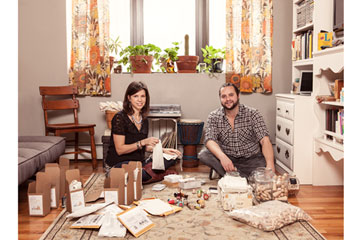
(5 of 6)
The venture funds that have pumped millions into Etsy didn't invest to promote the ideal of the independent craftsman. They want to make money, and that means Etsy has to grow--and change. Dickerson is the embodiment of those changes. He is a programmer, not an artisan. At Yahoo, his claim to fame was instituting "hackathons," marathons in which programmers were encouraged to geek out on improvised code instead of doing their work.
On a recent afternoon, Dickerson strolled through Etsy's 45,000-sq.-ft. (4,200 sq m) loft space in Brooklyn and into his office, where the gleaming acoustic guitar on display--yes, he knows how to play--signals that he has a creative side. (Etsy's decor--reclaimed-wood floors, handmade desks and vintage couches--is a holdover from Kalin's days.) In Dickerson's year-and-a-half-long tenure, he has beefed up the tech staff to make selling easier on the site, loosened the rules to allow a broader definition of collectives so successful sellers can grow and created a separate site, Etsy Wholesale, to connect growing sellers with big-box retailers.
"Defining handmade isn't simple," Dickerson says. "For us it's about the spirit of people buying and selling from other people. When you think about it that way, there's a lot of micro-entrepreneurship Etsy can support."
Plenty of ambitious artisans are O.K. with that. Others are quitting Etsy and turning to smaller competitors like ArtFire and Gawanda, even though those sites offer only a fraction of the traffic on Etsy. Some of the more sensitive buyers have also moved on, viewing the new and improved Etsy as another big-box label. "Etsy has turned handmade into just another annoyingly pretentious brand people have to have," says Winchell. "They've taken what's magic about it and turned it into Walmart."
Maybe not Walmart--yet. Etsy is, in fact, turning handmade into a brand for retailers such as CB2, West Elm and Anthropologie, which have been angling for a piece of the craftsman craze. The share of "handcrafted" goods sold at West Elm has nearly tripled over the past four years. (According to West Elm's definition, handcrafted includes merchandise made in small foreign factories with good working conditions.) Etsy sees this as an opportunity for sellers who want to scale up. "You try to make as many people as possible happy when you're a young company," says Stinchcomb of Etsy. "But we don't want to limit creativity."
Can products made in foreign factories hold true to the handmade ethos that started Etsy? The company will confront that question next. Its latest $40 million injection of venture capital is helping it expand further into other countries. Union Square's Fred Wilson--one of Silicon Alley's most celebrated VC brains--envisions an international network through which collectives of Etsy jewelers in, say, Turkey can sell regularly to customers in New York City and Tokyo. "There are some negatives to expanding abroad," Wilson says. "But once we light up a global marketplace where any seller can connect with any buyer around the world, we'll see phenomenal growth."
